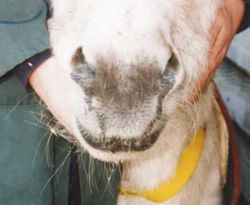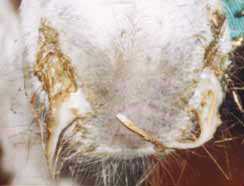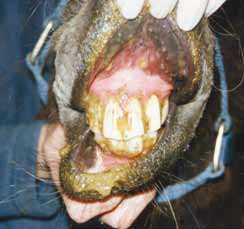Herpes Virus - Donkey
Equine/Asinine herpes virus infections
There are a number of herpes viruses which have been isolated from donkeys. These include EHV-1 and 4, and also AHV-1, 2 and 3. The genetic sequence of donkey herpes viruses shows a number of differences to the horse (Ficorilli et al, 1995). However, the diseases due to these viruses mirror those in the horse, namely, respiratory signs, neurological signs, abortion and coital exanthema lesions.
Clinical Signs

As in the horse, respiratory disease may be seen following infection and may range from mild to severe. The first symptoms are usually a clear watery bilateral nasal and often ocular discharge, pyrexia and lymphadenopathy. This may be accompanied by a cough.
Donkeys are often kept in small social groups as companion animals and not exposed to much mixing and travelling. Unfortunately this quiet lifestyle can lead to donkeys being very stressed by changing social groups and different events. This, in turn, reduces immunity to viruses and enhances shedding of herpes viruses by latently infected carrier donkeys. In such situations a donkey may become very sick with herpes virus infection, succumbing to secondary bacterial infection and hyperlipaemia. If infection is suspected, strict hygiene measures should be instituted to avoid spread to susceptible groups (Horserace Betting Levy Board Codes of Practice, 2003-2004).
EHV-1 infection has been reported to cause abortion in a donkey mare and characteristic lesions in the foal (Tewari et al, 1994).
Coital exanthema lesions are frequently seen in the donkey and respond well to general supportive therapy.
Diagnosis


Definitive diagnosis of herpes virus infections requires laboratory assistance.
Virus isolation
Within 48 hours of the onset of infection, when the donkey is still pyrexic, nasopharyngeal swabs are used to collect respiratory secretions from the back of the nasopharynx. The swabs are placed in a specially prepared transport medium, such as supplied by The Animal Health Trust. It is preferable to ask for foal or small pony swabs as the adult horse nasopharyngeal swabs are too large to fit up the narrow ventral meatus of the donkey.
Serology
Paired serum samples can also be used for serological diagnosis. An acute serum sample is required within two to three days of the onset of illness, followed by a second sample two to three weeks later. A positive result shows a fourfold or greater rise in virus specific antibody. In the donkey a non-specific and, as yet, unidentified anti-complement factor in the serum may be responsible for false positive results. If this is the case a virus neutralisation test(VN) may be required instead of a complement fixation test. However, the VN test is less used in many laboratories nowadays, as virus neutralizing antibodies have a longer half life compared to complement fixation antibodies, and so are less sensitive to recent rises.
Aborted foetuses
Aborted foetuses and foals that die shortly after birth should, if possible, be investigated at a laboratory to look for signs of EHV. If present it is important to follow the Horserace Betting Levy Board guidelines for minimising spread.
Treatment
Treatment depends on the severity of the condition and requires the use of antipyretics, antibiotics and possible nutritional support, combined with good nursing and isolation procedures.
Control
Vaccination of horses can be used to reduce the severity and lessen the spread of herpes virus infection within susceptible populations. Vaccines are available which contain inactivated EHV-1 and -4 to protect against respiratory and abortifacient strains of the virus. There is no specific information about the use of such vaccinations in the donkey, and the decision to implement a vaccination programme needs to be based on an assessment of individual risk.
Literature Search
Use these links to find recent scientific publications via CAB Abstracts (log in required unless accessing from a subscribing organisation).
Herpes Virus in donkeys publications
References
- Thiemann, A. (2008) Respiratory problems In Svendsen, E.D., Duncan, J. and Hadrill, D. (2008) The Professional Handbook of the Donkey, 4th edition, Whittet Books, Chapter 7
- Ficorilli, N., Studdert, M.J., and Crabb, B.S. (1995). ‘The nucleotide sequence of asinine herpes virus 3 glycoprotein G indicates the donkey virus is closely related to equine herpes virus 1’. Archives of Virology, 140 (9). pp 1653-1662.
- Horserace Betting Levy Board (2004). Codes of Practice for the Control of Equid Herpes Virus 1 (EHV-1) Infection.
- Tewari, S.C., Sharma, P.C., Prasad, S., Kaura, Y.K. (1994). ‘Experimental equine herpes virus 1 infection of foetus in a pregnant donkey mare’. Indian Veterinary Journal, 71(3). pp 213-214.
|
|
This section was sponsored and content provided by THE DONKEY SANCTUARY |
|---|
